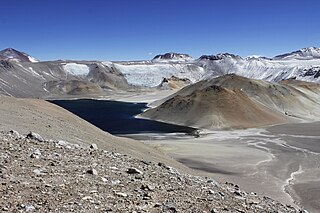Related Research Articles

Nevado Ojos del Salado is an active stratovolcano in the Andes on the Argentina–Chile border and the highest active volcano in the world at 6,893 m (22,615 ft). It is also the second highest mountain in both the Western Hemisphere and the Southern Hemisphere behind Aconcagua at approximately 7,000 meters and it is the highest in Chile. Nevado Ojos del Salado could be translated as "Eyes of the Salty One", which describes it as being very snowy in the winter and salty with many lakes.

Falso Azufre is a complex volcano at the border of Argentina and Chile.

Monte Pissis is an extinct volcano on the border of La Rioja and Catamarca provinces, Argentina, 25 km (16 mi) from the Chilean border. The mountain is the third-highest in the Western Hemisphere, and is located about 550 km (340 mi) north of Aconcagua. Monte Pissis is named after Pedro José Amadeo Pissis, a French geologist who worked for the Chilean government. Due to its location in the Atacama Desert, the mountain has very dry conditions but there is an extensive glacier

Incahuasi is a volcanic mountain in the Andes of South America. It lies on the border of the Catamarca Province of Argentina and the Atacama Region of Chile. Incahuasi has a summit elevation of 6,621 metres (21,722 ft) above sea level.

Copiapó, also known as Azufre, is a stratovolcano located in the Atacama Region of Chile. The volcano separates the two portions in which Nevado Tres Cruces National Park is divided. In its vicinity lies Ojos del Salado. At its summit an Inca platform can be found.

Zapaleri is a volcano whose summit is the tripoint of the borders of Argentina, Bolivia and Chile. A number of railways are in the area. It is part of Potosí Department (Bolivia), Jujuy Province (Argentina), and Antofagasta Region (Chile). The volcano formed on top of the 2.89 mya Tara Ignimbrite from the Guacha caldera and the basement beneath the volcano is formed from Cretaceous and Tertiary rocks affected by tectonic deformation. Volcanic rocks are andesite, basalt, dacite and rhyolite. Late Cretaceous rocks are also found in the area, as are Pleistocene shoshonite volcanic rocks.

Nevado San Francisco, or Cerro San Francisco, is a stratovolcano on the border between Argentina and Chile, located just southeast of San Francisco Pass. It is considered extinct and is one of the several 6,000 m (19,700 ft) peaks in the area, of which the chief is the Ojos del Salado.

Los Patos is a mountain in the Andes mountain range of South America. The peak is located on the international border of the Catamarca Province of Argentina and the Atacama Region of Chile. It has a summit elevation of 6,239 metres (20,469 ft).
Carrizalillo is a caldera in Chile. It is located in the Central Volcanic Zone and is part of the Paleocene-Eocene volcanic belt. The caldera is located 50 kilometres (31 mi) southwest of Copiapo. It is heavily eroded. Active during the Cretaceous, it is a large caldera. Post-collapse activity generated subsidiary calderas inside the older main caldera.

Incapillo is a Pleistocene caldera, a depression formed by the collapse of a volcano, in the La Rioja province of Argentina. Part of the Argentine Andes, it is considered the southernmost volcanic centre in the Central Volcanic Zone of the Andes with Pleistocene activity. Incapillo is one of several ignimbritic or calderic systems that, along with 44 active stratovolcanoes, are part of the Central Volcanic Zone.
Jotabeche is a Miocene-Pliocene caldera in the Atacama Region of Chile. It is part of the volcanic Andes, more specifically of the extreme southern end of the Central Volcanic Zone (CVZ). This sector of the Andean Volcanic Belt contains about 44 volcanic centres and numerous more minor volcanic systems, as well as some caldera and ignimbrite systems. Jotabeche is located in a now inactive segment of the CVZ, the Maricunga Belt.
Doña Ines is a volcano in Chile. It is a Miocene age stratovolcano which is formed from lava domes that form its summit area and nuee ardente deposits which form the flanks of the volcano.
Leon Muerto is a 4,799 metres (15,745 ft) high volcano in Chile.
Cerros Bravos-Barros Negros is a volcano in Chile.
Negro de Chorrillos is a volcano in the Andes.
Ojos de Maricunga is a volcano in the Maricunga Belt of Chile, in the Cordillera Domeyko.(Muñoz 1894, p. 51)
Pairique volcanic complex is a volcanic complex in the Jujuy Province, Argentina.
Pastillitos is a volcano in the Central Andes of Chile.
Wheelwright caldera is a caldera in Chile. It is variously described as being between 11 kilometres (6.8 mi) and 22 kilometres (14 mi) wide and lies in the Central Volcanic Zone of the Andes. A lake lies within the caldera, which is among the largest of the Central Andes. The caldera lies in the region of Ojos del Salado, the world's tallest volcano.
El Salvador is a caldera in Chile.
References
- ↑ XIV Congreso Geológico Chileno: Hacia un cambio de enfoque en exploración
- ↑ "CONSTANTINO MPODOZIS". Archived from the original on 2017-01-05. Retrieved 2016-08-14.
| | This article about a Chilean scientist is a stub. You can help Wikipedia by expanding it. |
| | This biographical article about a geologist is a stub. You can help Wikipedia by expanding it. |